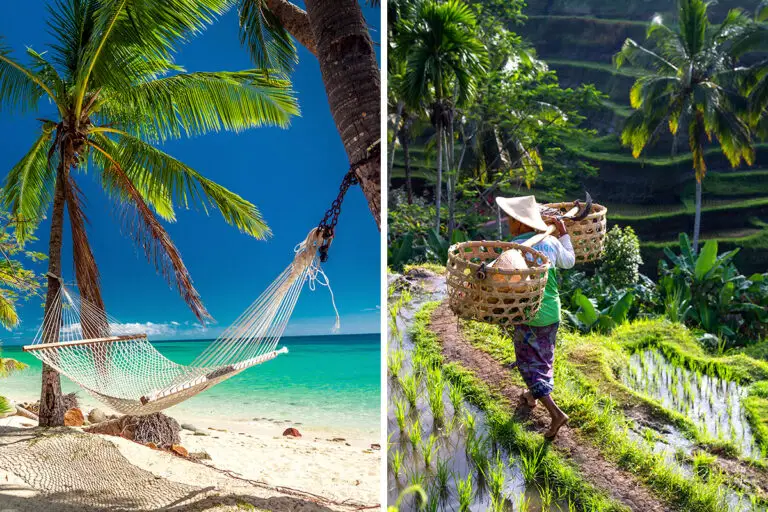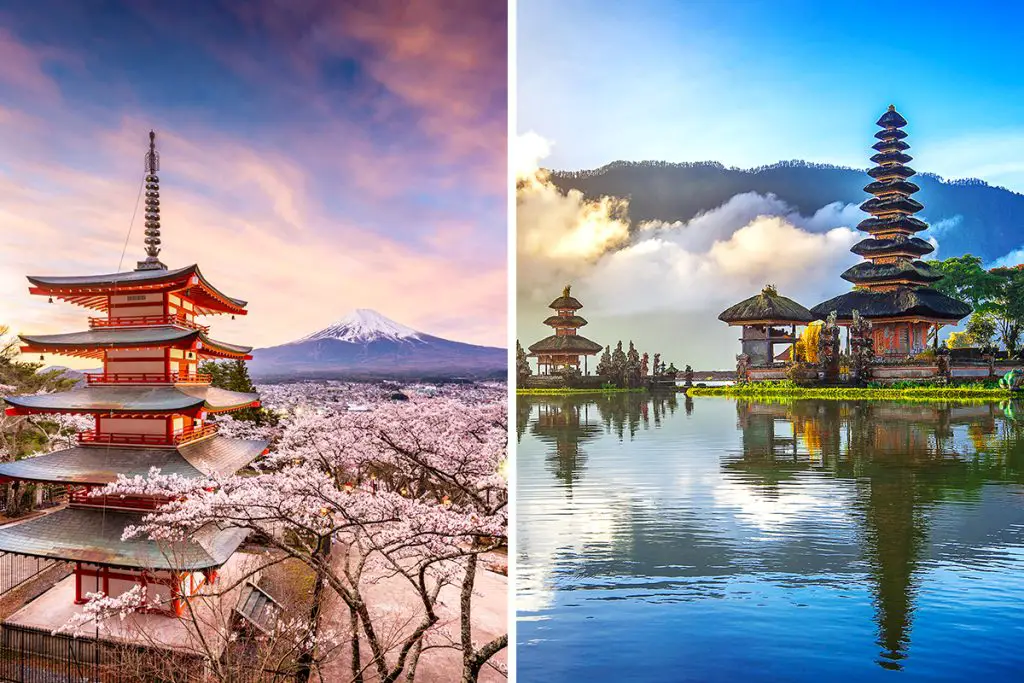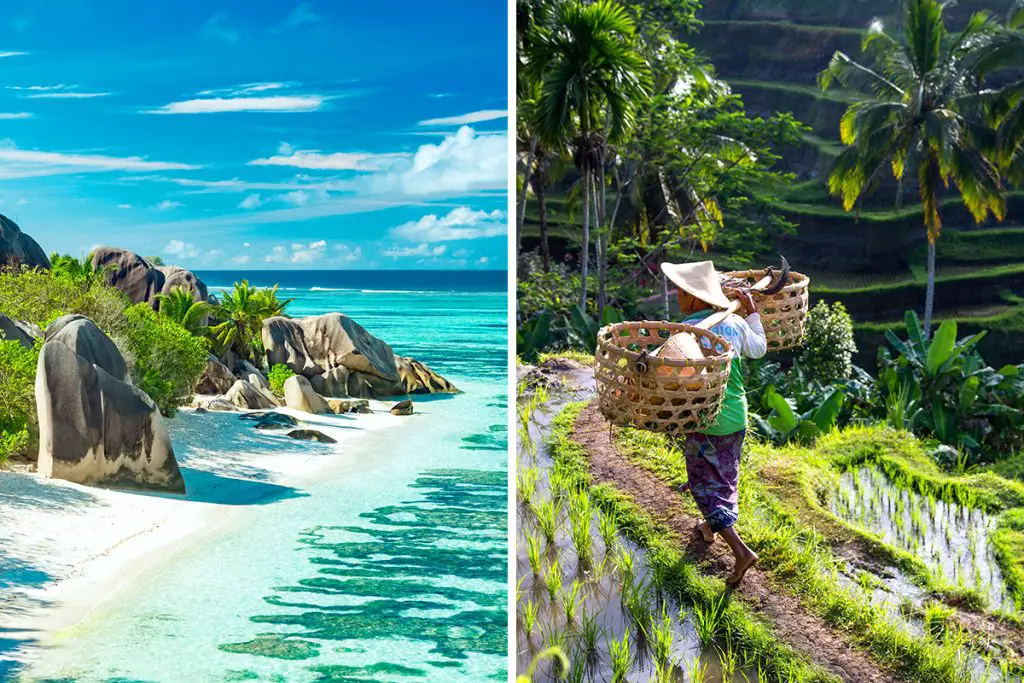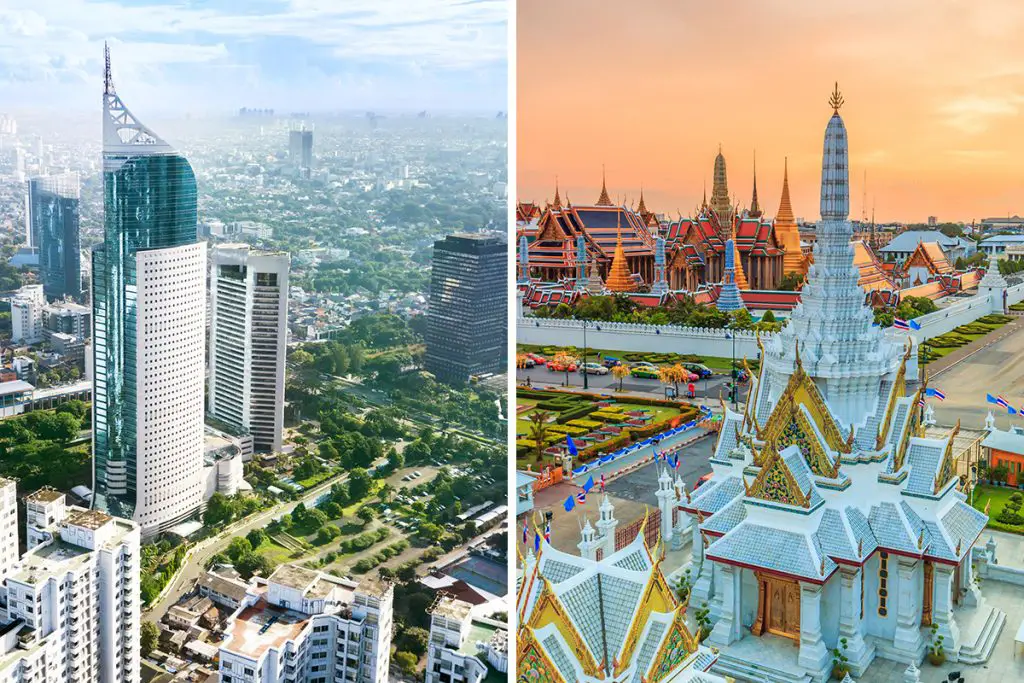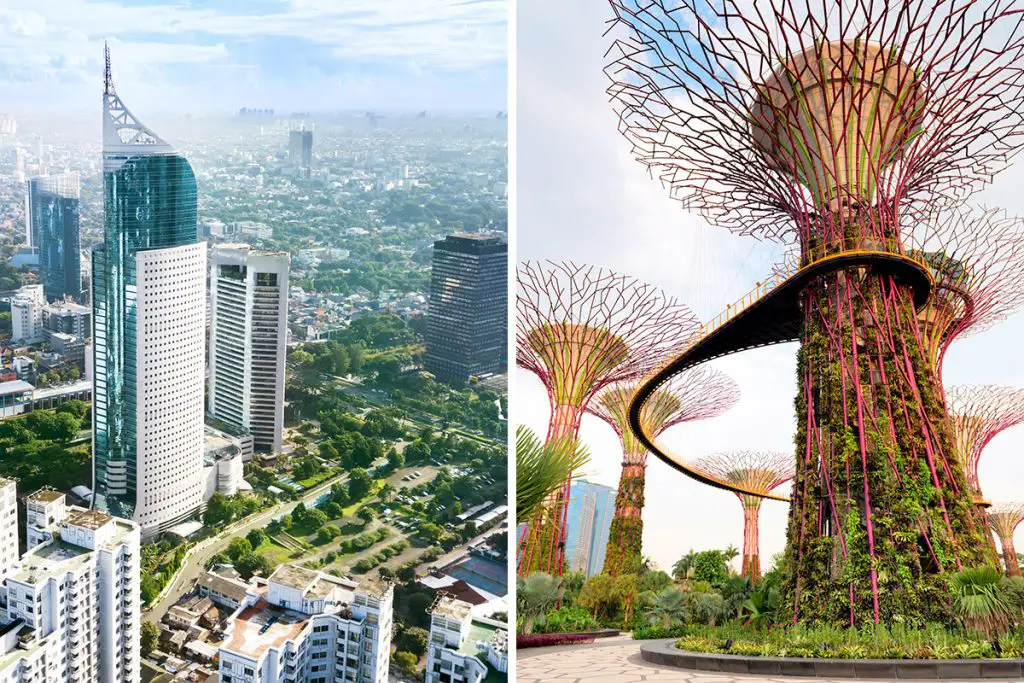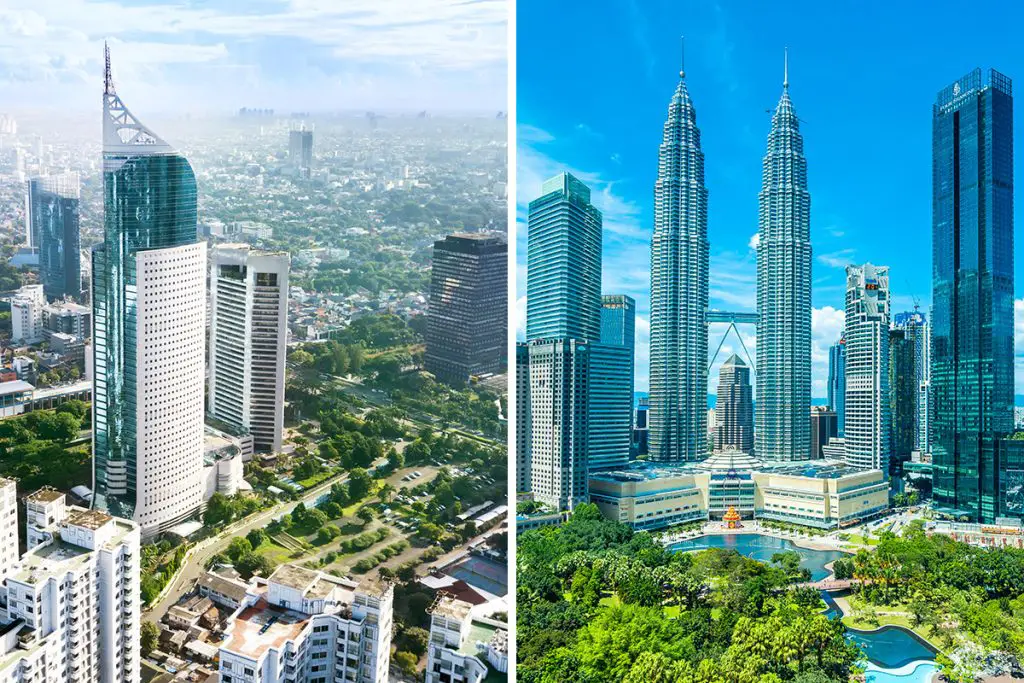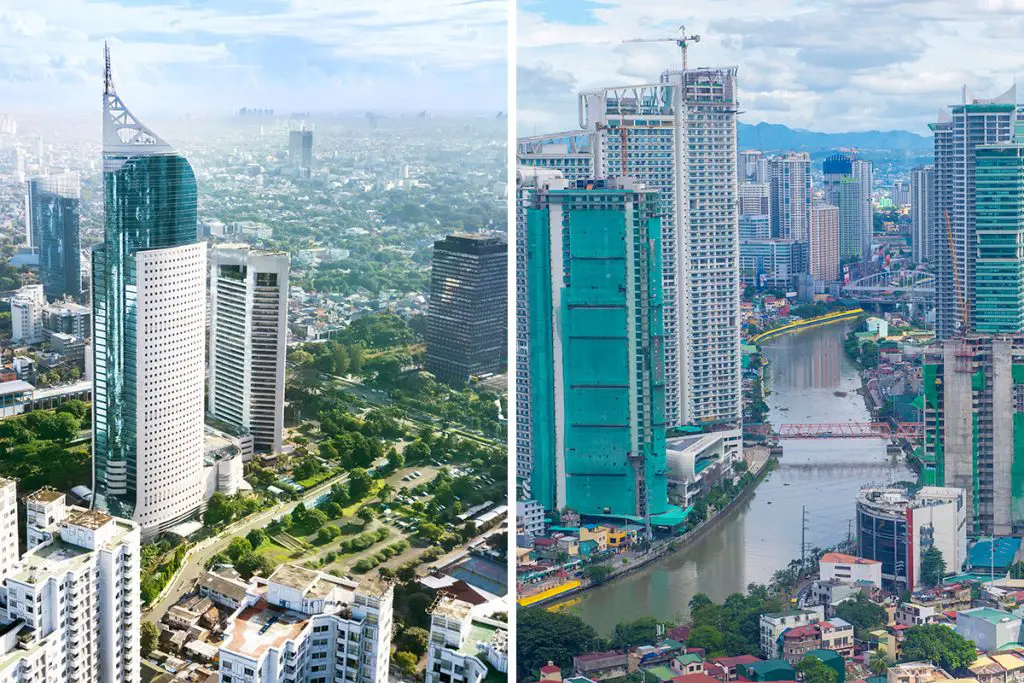Fiji is a Polynesian island located off the eastern coast of Australia. It is an archipelagic nation with more than 300 islands and islets. Fiji is famous for its wondrous beaches, amazing surf locations, and scenic landscapes.
On the other hand, Bali is an island designated as a province in Indonesia. It is a primary tourist destination that celebrates its history, culture, traditions, and beliefs. If you can’t decide between the two, you’ll learn more about Fiji and Bali below.
Fiji
The island of Fiji is located in the Oceanic region, east of Australia. With more than 300 islands, Fiji is an archipelagic island nation with a population of roughly 925,000.
Fiji has two major islands and several other smaller island groups. Viti Levu is the smaller of the two major islands. However, it serves as the primary tourist hub. The island of Viti Levu is adorned with numerous hotels and resorts along its coast and is the site for some of Fiji’s most famous surf spots.
Vanua Levu and the other island groups in Fiji feature untouched scenic landscapes. With fewer visitors, these islands are tropical paradises just waiting to be explored.
Tourists can both enjoy a relaxing day by the beach and exciting adventures deep in the mountains or in the sea. From world-class surf locations and scenic mountain trails to romantic private island experiences. Fiji’s natural beauty is something to explore and see.
What Makes Fiji Unique?
Amazing Surf Experiences
One of the main reasons why people travel to Fiji is because of its world-famous surf spots. Fiji is an archipelago comprised of several hundred islands. This means that tourists have a wide range of choices when it comes to beaches and surf locations.
There are a handful of beach breaks in Fiji that are perfect for amateur to intermediate surfing. The Natadola Beach and Sigatoka Sand Dunes by the Coral Coast are two of the most popular sites for relatively calmer waves.
However, Fiji is particularly famous for its mammoth waves perfect for pros and experienced surfers. Some of the most sought-after spots in Fiji include the Cloudbreak, the Namotu Lefts, and the Wilkes Passage.
The Cloudbreak features waves reaching up to 3 m (10 ft) high, allowing surfers to get the most out of its towering swells. The waves over Namotu Lefts and Wilkes Passage don’t get as high as the Cloudbreak. However, surfing around these parts can still be challenging. Waves come in a lot faster, making it hard to maneuver.
Discover Fijian Culture and History
Traveling to Fiji is more than just the beach and the sea. There are a lot more things to discover and uncover. This includes a number of historical and cultural sites that best represents the island’s culture and history.
Sri Siva Subramaniya Temple
The Sri Siva Subramaniya Temple is a Hindu temple located in the quaint town of Nadi. It sits right along the Nadi River and has served as a primary religious center since the 1900s.
It features unique Dravidian architecture that is exceptionally unique outside of India. The ornate and brightly colored temple is recognized as the larger Hindu complex in the Pacific region. Because of its design, the Sri Siva Subramaniya Temple is arguably one of the most iconic features of the island.
Fiji Museum
When it comes to learning about a place’s history, there is no better way than to visit its local museum. The Fiji Museum, while relatively small, is home to an expansive collection of historic materials and artifacts.
Museum exhibits uncover the island’s pre- and Indo-Fijian history. It also features galleries celebrating Fiji’s bark-cloth culture, natural history, and local art. You can find the Fiji Museum in the Thurston Gardens in Suva, Viti Levu.
Endless Island Exploration
With roughly 330 islands, it would be impossible to visit every single island in Fiji in just one trip.
Viti Levu and Vanua Levu are Fiji’s largest islands. You can find most of Fiji’s tourist attractions and destinations in either one of these locations.
Viti Levu is particularly considered the primary tourist hub. It is home to Fiji’s primary airports and is more developed. There are several beach resorts along its coast and it also provides access to some of the island’s most popular tourist attractions. This includes the Sigatoka Sand Dunes National Park, the Coral Coast, and the Navua River.
Vanua Levu, on the other hand, offers a more subdued Fijian experience. Instead of luxury hotels and shopping centers, Vanua Levu is perfect for adventures and nature explorations. Tourists can explore the island through trails in the Wasalit Nature Reserve and the Flora Tropica Gardens.
Snorkeling and diving are also popular in Vanua Levu. The Namena Marine Reserve and Rainbow Reef are some of the spots tourists sought after.
But other than the main islands of Viti Levu and Vanua Levu, there is more to Fiji for tourists to discover. One of the best ways to explore the Fijian archipelago is through the Blue Lagoon Cruise. The days-long cruise travels through the farther Yasawa and Mamanuca island groups.
Limitless Nature Adventures
One of Fiji’s biggest charms is its remarkable beauty. It features lush mountain ranges, thick rainforests, and pristine coastlines. Aside from taking in Fiji’s scenic landscape, tourists can also experience Fiji’s beauty through an array of activities.
Navua River
Located on the island of Viti Levu, the Navua River is one of the most popular tourist attractions in Fiji outside of its beaches and surfs.
Navua River takes water activities to a different level. Tourists can either take a scenic boat ride amidst the mountains or go wild-river rafting. The 40-mile-long (65 km) river system is one of the best ways to experience Fiji through beauty and adventure.
Bouma National Heritage Park
When it comes to untouched landscapes, the Bouma National Heritage Park is one of the best places to explore Fiji’s nature. Its numerous hiking trails traverse through the island’s coast and forests.
However, one of its main attractions is the hike heading to the Tavoro Waterfall series. The highlight is the 75 ft (24 m) high falls with a stunning natural pool at the bottom. There is also a second and third waterfall that takes tourists higher and deeper into the lush mountain.
Bali
The province of Bali lies on the southern central end of the Indonesian archipelago. The province consists of the main island of Bali and a neighboring island group known as the Nusa Islands. Drawing thousands of visitors for its beauty and heritage, Bali is famous as the country’s top tourist destination.
The island features dominating landscapes. Including a mountain over 9,000 feet (2643 m) tall, active volcanoes, tall limestone cliffs, deep valleys, and even a lava field.
Bali also has a fair share of stunning beaches. With clear blue waters, calm crashing waves, and the perfect amount of green for shade. Bali’s tropical climate and natural beauty make it a perfect summer destination.
However, Bali has more to offer than just its scenery. The island is home to numerous sacred temples. Some are tucked deep in the forests, high up in the mountains, or right along the sea. There are also museums and parks that celebrate Bali’s way of life. Traditional Balinese and Hindu culture and beliefs are strong and present in many of these attractions.
Bali offers some of the most unique experiences. From scenic adventures to awe-inspiring attractions, there is so much to explore and discover in Bali.
What Makes Bali Unique?
A Collection of Historic Temples
No visit to Bali is complete without venturing into some of the most popular and important temple complexes on the island.
Ulun Danu Batur Temple
Built by Lake Bratan, the Pura Ulun Danu Bratan is one of the most important temple complexes in Bali. The temple was built dedicated to the Goddess Danu, which is the queen of water, rivers, and lakes.
The site of the Pura Ulun Danu Bratan has been a center for religious rituals as far back as the megalithic period. The temple itself is believed to have been built as early as the mid-1550s.
The complex is comprised of four sacred buildings that serve as places of worship. It features a particular building style and design that is based on the Trimurti belief. The Pura Ulun Danu Bratan is one of Bali’s most iconic landmarks and is even featured in Indonesia’s 50,000 rupiah bill.
Uluwatu Temple
The Uluwatu Temple is another sea temple along the southern coast of Bali. Perched on top of a 70 m (229 ft) high cliff, the temple holds significant cultural and religious significance to the people of Bali.
According to Balinese Hindus belief, the Hindu Trinity powers merge here and now serve as a place of worship for the deity of all elements, Siva Rudra.
The scenic location of the temple provides amazing views. Visitors can also witness Balinese Kecak and fire dance performances on the site.
Pura Tanah Lot
The Pura Tanah Lot is arguably one of the most photographed temples in Bali. Sitting on a rock formation off the coast, Tanah Lot is a temple dedicated to Balinese sea gods and is one of the seven sea temples in Bali.
Aside from its cultural importance, Pura Tanah Lot is exceptionally popular because of its scenic backdrop. The rocky temple provides a great contrast against the crashing waves and the deep blue sea. However, many look forward to seeing and photographing the iconic temple during sunset.
Lempuyang Temple Complex
Located in the eastern region of Bali, the historic Lempuyang Temple Complex is one of the oldest religious sites on the island. It is situated within the highlands of Mount Lempuyang, roughly 5,800 ft (1,775 m) above sea level.
Predating most of the temples in Bali, the Lempuyang Temple is one of the six main temples on the island. The complex is comprised of six sanctuaries that are regarded as Bali’s holiest places of worship.
The Lempuyang Temple Complex also features the renowned Gateway of Heaven, which is one of the most iconic features on the island.
Besakih Temple
The Besakih Temple in Mount Agung features roughly 86 temples and shrines and is recognized as the largest complex in Bali. It is a primary pilgrimage site and is considered the holiest of Bali’s temples.
Immerse in Indonesian Art and Culture
Visiting Bali is one way to indulge in Indonesian culture and art. You can visit museums and centers that celebrate the country’s unique traditions and masterpieces.
Agung Rai Museum of Art
Located in the meek town of Ubud, the Agung Rai Museum of Art (AGMA) is home to one of the most impressive private collections in the country. Established in 1996, the museum features work from Balinese, Indonesian, and foreign artists. It also has a collection of classical wayang paintings and Indonesian ceremonial daggers.
Neka Art Museum
Established in 1982 by a renowned Indonesian art dealer, the Neka Art Museum incorporates art and nature. The museum features a series of galleries presenting classical paintings and contemporary art. The Neka Art Museum also features an open garden with pavilions and halls draped in Balinese design.
Setia Darma House of Masks & Puppets
The Setia Darma House of Masks and Puppets celebrates a unique element of Indonesian culture. The renowned museum features traditional masks gathered from different parts of the country. It aims to celebrate, preserve, as well as raise awareness of the diminishing tradition of mask and puppet art in Indonesia.
Ubud Art Market
The Ubud Art Market is arguably one of the best places to shop for local art and products. Hundreds of vendors set up shop at the center of the town every day from 9 am to 6 pm. The Ubud Art Market is filled with a wide array of traditional items. You can find sarongs, jewelry, woven handbags, wood homeware, handicrafts, and souvenirs.
Puri Saren Royal Ubud Palace
Located in the heart of Ubud, the Puri Saren Royal Ubud Palace served as the residence of the royal family. Tucked between two temples, the historic site dates back to the 1800s. It is a primary tourist attraction in the area and is known for its well-preserved architecture.
Other than its traditional design and beauty, the Puri Saren Royal Ubud Palace is also a center for art, dance, music, and literature. Visitors can witness traditional performances and events that regularly occur in the palace.
Uncover Bali’s Natural Beauty
Bali is an undeniably beautiful island. From grandiose mountains and intimidating volcanoes to some of the prettiest coastlines. Bali’s landscape can be both soft and rugged, calming and exciting. There are definitely hidden spots and gems on the island that you cannot miss.
Sacred Monkey Forest Sanctuary
The Sacred Monkey Forest Sanctuary is undoubtedly one of the most popular tourist attractions on the island. Located in the town of Ubud, the monkey forest features the perfect balance and peace between animals, humans, and nature.
Set in a thick forest, visitors can spot hundreds of grey long-tailed macaques that roam free. They are generally friendly companions that confidently interact with people in the area.
But aside from the adorable monkeys, the Sacred Monkey Forest Sanctuary holds more to discover. The roughly 30-acre (12 ha) nature park also features old temples and statues. The temple ruins covered in moss, vines, and foliage add a mystical and historic ambiance to the place.
Some of the must-visit spots in the Sacred Monkey Forest Sanctuary are the Pura Dalem Agung Padangtegal and Pura Beji.
The Pura Dalem Agung Padantagal is a 14-century temple located on the southwestern side of the nature park. On the opposite end of the forest is the Pura Beji which served as an ancient bathing temple.
Mount Batur
Regarded as one of the holiest and most sacred places on the island, Mount Batur plays a critical role in Balinese life. Standing at a towering 5,633 ft (1,717 m), Mount Batur is one of the tallest mountains in Bali, next to the 1,888 ft (3,014) high Mount. Agung.
Mount Batur is an active volcano that features two calderas caused by a magma chamber collapse thousands of years ago. Within the caldera lies a 2,296 ft-tall (700 m) stratovolcano that had mild-to-moderate explosive activity, most recently in 2000.
Despite this, the surrounding areas of Mount Batur are quite populated. A lava field has formed on one side of the mountain and now has become a tourist attraction for rough 4WD adventures.
Hiking Mout Batur is a popular tourist activity. There are numerous trails heading up to the mountain’s center crater. However, most tourists opt for the famous Batur Sunrise Hike which often starts at midnight. The viewpoint from Mount Batur offers panoramic looks of the caldera with the grandiose Mount Agung in the background.
There are also several tourist attractions and destinations near Mount Batur. There is the renowned Toya Bungkah Hot Springs, the Besakih Great Temple, the local Museum Geopark Batur, and the Batuan Village.
Sekumpul Waterfall
Located in Singaraja in north Bali, the Sekumpul Waterfall consists of a series of waterfalls tucked in lush rainforest. Unlike other mountain falls, the Sekempul has a unique feature. This natural wonder consists of two primary waterfalls with different sources.
There is a 262-foot-tall (80 m) cascade with a strong singular stream. Next to it is a taller 328-foot-tall (100 m) cascade that graciously dangles over the cliff and casts a wide stream down.
There is a viewpoint near the entrance of the Sekumpul Waterfall which allows visitors to appreciate its beauty from afar. A short but quite challenging 5- to 10-minute hike will take you directly to the bottom of the falls. There is a small natural pool and a clear river perfect for a quick swim.
Aside from the main Seukumpul Waterfall attraction, there are several more waterfalls within the same area. There are the Secret Waterfalls, the Lemukih Waterfalls, the Bembengan Waterfalls, and more.
The Nusa Islands
The Nusa Islands offer the perfect opportunity to enjoy Bali as a tropical summer paradise. Situated off the southern coasts of Bali, the Nusa Islands provide the perfect escape from the hustle and bustle over the main island.
The Nusa Island group consists of three smaller islands. This includes Nusa Lembongan, Nusa Ceningan, and Nusa Penida. These are dubbed holiday islands with pristine beaches, scenic views, and great hotels. However, each island has its own charms that effectively draw tourists.
Nusa Lembongan lies closest to the coast of Bali. Therefore, it is the most accessible for tourists coming from the main island. Nusa Lembongan is known for its amazing beaches such as Mushroom Beach, Dream Beach, and Paradise Beach.
There are several other attractions right off the coast of Nusa Lembongan. The Playground and Shipwrecks are popular surf breaks near Mushroom Bay. They feature amazing swells perfect for beginners and experienced surfers.
The smallest Nusa Ceningan is just a bridge away from Nusa Lembongan. To get here, you can cross through the Bridge of Love. This 460-foot-long (140 m) pedestrian bridge connects Lembongan to Ceningan and offers panoramic views of the vast Indian Ocean. The most popular attractions on the island include the turquoise-colored Blue Lagoon and the Abyss Zipline.
Nusa Penida is the largest of the three Nusa Islands. Here, you can spot one of the most idyllic places in the Nusa Islands. The famous Crystal Bay has picture-perfect features. From the lush mountains on each side, the limestone cliffs, to the crystal clear blue waters that open to the Indian Ocean.
However, diving is a particularly popular activity in Nusa Penida. There is the famous Manta Point where tourists can swim with spotted rays and nurse sharks. There is also the unique Temple Point which features statues and Buddha carvings underwater.
There are several other tourist attractions in Nusa Penida. This includes the National Park Foundation Bird Sanctuary, the Penataran Temple, and the Goa Giri Putri cave.
Balinese Heritage Through the Subak System
There is no denying that Bali has a rich culture and impressive history. From temples thousands of years old, long-lived practices, and strong belief systems.
Bali has several locations listed as World Heritage sites. In 2012, UNESCO collectively recognized Bali’s ancient irrigation system (known as subak) as a World Heritage.
The subak is a complex water management system developed in the 9th century. This system allowed people to direct and divert water coming from the mountain springs down to low-lying communities.
UNESCO believes that this system is a physical representation of the Balinese Tri Hita Karana philosophy. This philosophy exemplifies harmony with God, among people, and with nature.
The sites listed in the World Heritage recognition represent the connection of subak and the Tri Hita Karana philosophy. This includes the temple of Ulun Danu Batur, the royal Taman Ayun Temple, the Pakerisan Valley, Lake Batur, and Carur Angga Batukaru.
Is Fiji or Bali Better?
Fiji and Bali are two equally popular tourist destinations. Despite being in two different spots on the globe, Fiji and Bali have some things in common. Both are tropical islands with picturesque mountains, stunning beaches, as well as rich cultures.
However, there are also some distinct differences too. Fiji leans toward luxury and high-end experiences. From romantic cruise ships, and high-class resorts, to private islands all for you.
On the other hand, Bali speaks more to heritage, culture, and experiences. There are countless temples and museums celebrating Balinese beliefs and traditions. You can also experience nature to a different degree. Get the chance to socialize with the macaques, dive with rays and sharks, and even hike close to the clouds.
Despite this, there is no loss whether you decide to go to Fiji or Bali. Fiji’s culture and Polynesian influences are well alive in its tourist attractions. At the same time, Bali shares similarly beautiful landscapes. You can’t go wrong with either destination.
FAQ
Is Fiji Safer Than Bali?
Bali and Fiji are relatively safe tourist destinations. Most crimes that occur in both areas are petty and nonviolent. This includes the likes of pickpocketing, theft, ATM scams, and so on.
General safety precautions are advised when traveling to either Bali or Fiji. Keep your doors locked, protect your valuables, and be aware of your surroundings.
However, another safety concern when traveling to Fiji or Bali involves natural disasters. Bali is known as seismically active and may experience small quakes from time to time.
On the other hand, the tropical island of Fiji is prone to typhoons and cyclones during particular months of the year. The cyclone season in Fiji lasts from November to April. During this time, flooding is quite common, especially in lower areas like Nadi and along the Coral Coast.
Is Fiji Cheaper or More Expensive Than Bali?
Fiji is considered a much more luxurious and high-end travel destination compared to Bali. Considering that Bali is in Southeast Asia, it’s considered cheap, especially for western tourists.
The average cost for accommodation, transportation, and food in Bali is around $61 per day. That is less than $500 for a week. On the other hand, Fiji costs significantly more with an average daily cost of around $140, which is roughly $1000 for seven days.
The main difference between the two is that hotels and resorts are generally more expensive in Fiji. It’s possible to find good accommodation in Bali for around $10 to $20 a night. On the flip side, Fiji’s more developed hotels and resorts cost around $80 to $100 per night’s stay.
Fiji vs. Bali Beaches
Both Fiji and Bali are tropical paradises. It’s easy to find pristine beaches and clear blue waters wherever you are. However, Fiji and Bali’s beaches do have some notable differences.
Fiji is characterized by mostly palm-lined fine-sand beaches with coral reefs a few feet from the shore. Depending on what side of the island you’re at, the water can be calm and subdued or rough and crashing. Either way, Fiji is perfect for activities such as snorkeling and surfing.
On the other hand, Bali features a more rugged landscape. You can still find the same palm-lined beaches in some of Bali’s most popular tourist areas. However, there are some beaches tucked between limestone cliffs that offer a new but equally picturesque scene.
Fiji or Bali for Honeymoon?
Fiji and Bali can be amazing honeymoon destinations. They both feature amazing landscapes as well as an array of activities for you to enjoy.
Fiji has several private island resorts that are perfect for romantic getaways. You can enjoy its serene tropical beauty and have an intimate vacation while escaping large crowds.
Bali, on the other hand, is more known for its outdoor adventures and rich culture. You can spend your honeymoon exploring its numerous historical sites and cultural attractions. You can also take your adventures outdoors and end the day with a relaxing traditional massage.
Bali or Fiji for Family Holiday?
Bali and Fiji both have something to offer for family vacationers. However, Bali would be the cheaper option, especially when it comes to large families.
There are several affordable accommodation options in Bali that fit large groups traveling on a budget. For younger families, some hotels offer play clubs and activity programs to keep them busy. You can also hire babysitters at a reasonable price to keep watch of your kids.
As for tourist attractions, you can take your kids to visit nearby temples. You can introduce them to local culture and traditions, try a variety of delicacies, and enjoy a calm day by the beach.
Fiji also has family-friendly hotels and resorts. However, it would cost significantly more compared to Bali. You can take your kids swimming and snorkeling by the beach but be wary of possibly rough waves and strong currents.
Are Fiji and Bali the Same?
Fiji and Bali share several similarities that make them popular tourist destinations. Both are tropical islands with stunning beaches and picturesque mountains. They offer a wide range of water sports and outdoor activities, making them perfect for adventure seekers.
Additionally, both Fiji and Bali have rich cultural heritage and are home to several ancient temples and historical landmarks that attract visitors from all over the world. Overall, despite being located in different parts of the world, Fiji and Bali share many similarities that make them both amazing travel destinations.
While the abovementioned may be true, their features and characteristics are not exactly the same.
Fiji is an archipelago comprised of several smaller islands. On the other hand, Bali is an island that is part of the Indonesian archipelago. Fiji is an island nation while Bali is only a province of Indonesia.
Fijian culture is influenced by Polynesian beliefs and practices. On the other hand, Bali is highly influenced by Hindu and Indonesian cultures.
Fiji’s landscape is characterized by grandiose and lush mountain ranges. Bali, on the other hand, feels and looks a bit more rugged with its limestone cliffs, stiff peaks, and active volcanoes.
Where Is Fiji in Relation to Bali?
The island of Fiji lies roughly 4,260 miles (6,856 km) away from Bali, Indonesia. Travel time from Bali to Fiji can take as long as 16 to 26 hours, including transfers and layovers.
There are no direct flights from Bali to Fiji. Tourists heading to Fiji would need to fly to Australia first and land either in Melbourne, Sydney, or Brisbane. From there, they can take another flight to reach Viti Levu in Fiji.
Is Fiji or Bali Closer to Australia?
Fiji and Bali lie on opposite sides of Australia. Therefore, Bali is closer to the western half of Australia while Fiji is closer to the eastern half of the continent.
The major city of Perth on the west coast of Australia is closer to Bali and has a travel time of roughly 4 hours. On the other hand, eastern cities of Australia including Melbourne, Sydney, and Brisbane are closer to Fiji. Travel time from these cities to Fiji takes roughly 3 to 6 hours.

